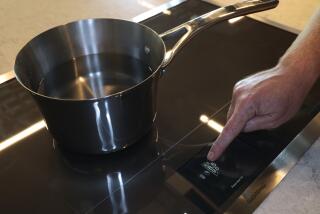Home Improvement : Dryness Sensor Vital Part in Dryer
- Share via
QUESTION: I need to replace my old clothes dryer. How expensive is it to operate a gas or electric dryer and what features should I look for in a new energy-efficient dryer? Should I vent it indoors in the winter?
ANSWER: A clothes dryer, particularly an electric one, is one of the major energy consumers in your home. The average U.S. household does 416 dryer loads each year with annual operating costs as high as $100. If you have several young children, you probably do even more loads.
Although the initial price of a gas dryer is a little more than an electric one, it is usually less expensive to operate. Based on national average utility rates, it costs about 75% less. This can total hundreds of dollars of savings over the life of the dryer.
Selecting an energy-efficient dryer can greatly reduce the operating costs. Precise control over the dryness level is most important. Over-drying not only wastes energy, but it damages the fabrics and causes wrinkling. You often have to iron over-dried clothes, wasting even more electricity.
The best and most energy-efficient dryness control is an electronic moisture level sensor. It is built into the drum and it actually touches the clothes in the dryer. When it senses your selected level of dryness, the dryer shuts off. In the permanent press cycle, the dryer slowly cools and continues to periodically tumble the clothes to reduce wrinkling.
Some so-called dryness controls sense dryness indirectly by measuring the exhaust air temperature (it gets hotter as the clothes get dryer), but these controls are less precise. Unless you are very conscientious about checking the dryness, a timer offers the least control.
Although an electronic control panel looks good, a manual dial is just as functional, particularly if you use the timer. You can see the position of the dial and roughly determine where in the cycle it is. If you have mixed fabrics, you can take out some faster drying fabrics earlier.
A front-located lint screen is best. You see it each time you open the dryer door, so you won’t forget to clean it. One new dryer model has a buzzer to signal you when the lint filter needs to be cleaned.
Venting an electric dryer indoors can save energy, but it may cause moisture problems in some houses. You can buy inexpensive switchable indoor/outdoor vent units with built-in lint filters. Check your local codes to be sure indoor venting is approved.
You can write to me at the address below for Utility Bills Update No. 006 showing a list of manufacturers and model numbers of gas and electric dryers with true moisture level sensors, of switchable indoor/outdoor vent units and a list of energy-saving laundry tips. Please include $1 and a self-addressed stamped business-size envelope.
Old Window Replicas Can Be Energy Saving
Q: I am restoring an old house and it needs new windows. One of the original wood windows still remains. Should I try to duplicate it or install new energy-efficient windows?
A: You should be able to do both. Several of the major wood window manufacturers can make custom windows of an energy-efficient design to match the original windows. You can do some of the minor detailing yourself by hand.
You should select double pane windows with a low-E coating on the glass. Argon-filled glass also saves energy and minimizes outdoor noise.
Letters and questions to Dulley, a Cincinnati-based engineering consultant, may be sent to James Dulley, Los Angeles Times, 6906 Royalgreen Drive, Cincinnati, Ohio 45244.
